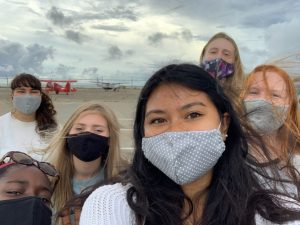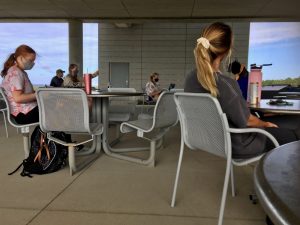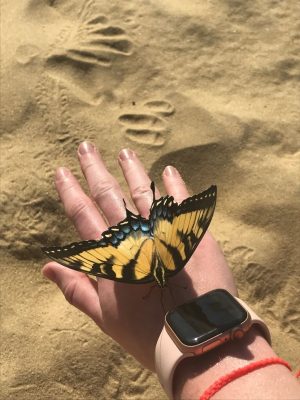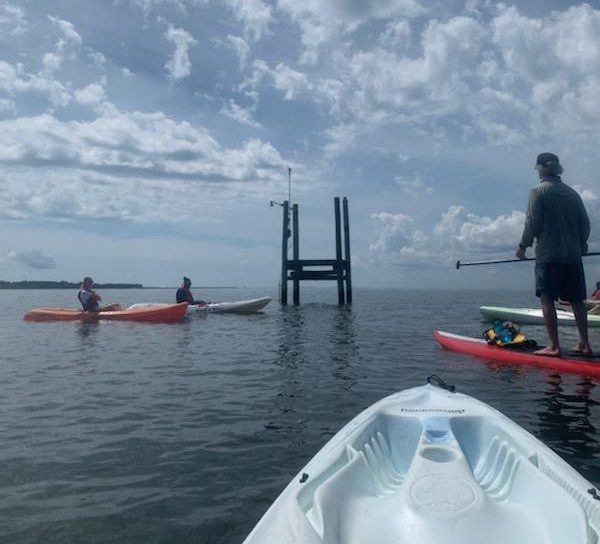Written by Lauren Colonair.

My journey with the UNC Institute for the Environment Outer Banks Field Site (OBXFS) program started three years ago, in a first-year environmental class. I cannot recall which class, or even which semester I was in when I heard the presentation. All I remember is the immediate desire to go to the Outer Banks and study at the Coastal Studies Institute (CSI) before I graduated. However, I did not know it would be three years before I would take advantage of this opportunity nor that it would occur during a pandemic.
This year, ten students from the University of North Carolina at Chapel Hill are participating in the Outer Banks Field Site. All of us come from different backgrounds and experiences, and all are here for different reasons. However, since we started this program we have all been linked together by one common goal. We are here not only to further our educational pursuits but to do so during the COVID-19 pandemic, a fact of life that requires us to participate in this program in a manner that is very different from groups in the past.
Waiting in Uncertainty
Some of us signed up for this field site long before COVID-19 was making headlines on news stations around the world. Many decided to embark on this adventure due to fears of what classes on campus would look like in the fall. Despite the reasoning, all of us endured a long summer of unknowns.
Emma Bancroft, an Environmental Science major in her Junior year, reminisced about the summer experience, “It was a little stressful not knowing any details, but no one knew any details, it was the same for everything in our lives.”
Our instructors and directors kept us up to date with the information they had as the summer progressed, but it remained unknown as to whether or not we would be studying in person for quite a long time. From decisions about classroom space to discussions about housing arrangements, we waited patiently on the other side of our computer screens for the go-ahead. Luckily, the green light to proceed was given and a few weeks later we found ourselves in Manteo, North Carolina, preparing for the start of Orientation.
New Beginnings
The first two weeks of our time at the field site were very different then what most students experience during the start of the fall semester. Instead of finding classroom buildings and reading over syllabi, we found ourselves rising early in the morning to climb large sand dunes, kayak in the sound, and hike in the maritime forest.
We, of course, did classwork too, although this too was different from the usual experience. Instead of going to a classroom, we sat at individual outdoor tables under a covered cement slab. All around us lay marsh plants and snaking inlets leading out to a beautiful sound. As we worked on team contracts for our research project and group dynamic activities, we were surrounded by gorgeous views.
The process of settling in was interrupted with uncertainty, however, when UNC’s main campus shut down and shifted to online instruction for undergraduate students on August 19th due to a rise in on-campus COVID-19 cases. As we read over the email from the UNC Chancellor’s office, no one was sure what would follow. Our instructors and the Study Abroad office reached out for an exemption to online instruction and we were left waiting until August 24th. During that time we continued with our orientation activities, each of us doing all we could to keep everyone safe. All the while knowing that our last day in person could be only one email away.

“I felt like every time we had class I would think, how are we going to do this online,” Janis Arrojado, a Junior majoring in Environmental Science and Geography said when asked about this time.
Fortunately, our program’s dedication to practicing social distancing, wearing masks, carrying hand sanitizer, and staying isolated from possible infection paid off. UNC and East Carolina University, the host school of this site, offered the field site an exemption.
“Since I’ve been here, I’ve been really impressed by how everyone is handling everything, everyone is wearing their masks,” Bancroft commented when asked about her experience so far.
This was, of course, wonderful news, all of us were excited to continue our work here, in person. Now though, we have a new weight on our shoulders. We want to ensure this decision proves to be a good one and be part of the proof that scientific, educational, and community-oriented work can continue during this unprecedented time if the right precautions are followed.
Socially-Distanced Learning Together

The current situation has increased the uniqueness of our time here. No matter what the future holds for us, we will always be the first group of students to set forth on such an endeavor, at this field site. The mark of COVID-19 and the hurdles it has presented us with can be seen in almost everything we do.
As mentioned above, we have been participating in class in an outdoor space since arriving here. At first, it was strange to arrive at school and avoid entering the building. We instead headed to the back of the structure, flipped over our tables, and began to disinfect them before starting our day. As time went on, the charm of the outdoor classroom grew on us, in part because of the views. Our
instructors joked that they usually try to hide the views from field site students as they can be distracting, and to an extent, they were right. It has not been easy to stay focused on what is going on while crabs crawl through our classroom and the boats exit and enter the inlets. Yet, it has also added an element of peace and tranquility to the entire experience. We are always immersed in the environment around us. We have no option but to be a part of the place in which we are studying. At this point, having class right next to the marsh is an intrinsic part of this experience, something that has connected all ten of us to the land, water, sea, and sky that we are leaving a mark on throughout this semester.
“It’s really pretty and so much of what we are doing is supposed to be outside, so there is a silver lining,” Bri Thompson, a junior majoring in Environmental Studies and Public policy, said of the outdoor classroom.
Field Trips & Hands-on Learning
Our first two weeks involved many field trips. Some served as a way for us to become familiar with our surroundings, and others provided us with basic information about the watershed which we will be working in for our research project. All of them required physical exertion, which was not made any easier by the constant presence of masks.
Our first excursion was a history hike at Jockey’s Ridge, the tallest active sand dune in the eastern United States. It was a beautiful day and we were able to see amazing wildlife, including an Eastern Tiger Swallowtail butterfly. We learned about the composition, movement, and history of the sand dune. This involved the story of how the area became protected, we also took a detour to observe fulgurite, which is formed when lightning strikes the dune.

It was a very hot day, and after walking up and down the dunes in our masks, the following introduction to the watershed in Nags Head was quite grueling. We had lunch together at a park and listened to local town officials explain the engineering and human dynamics of the work we will be doing. Fortunately, one of our instructors noticed how hot and generally exhausted we all were. She graciously invited us to meet in her backyard where she provided us with frozen treats and seltzer water. We discussed the watershed further and finished the last leg of our day feeling refreshed. Although hiking Jockey’s Ridge wearing face masks was not ideal, our group found a bonding moment in the experience and had the comfort of knowing we were keeping ourselves, each other, and the general public safe.
Bancroft captured the sentiment perfectly, stating, “It is exhausting being outside and also having to wear a mask. It’s hard to think about what we would be doing if all of this wasn’t happening. We could be hiking and kayaking and going on more field trips, it’s a little sad. But at the same time, I’m thankful because we still get to do things in person, and without that, it would take away the whole point of this field site. We get a lot more out of it.”
We have also found camaraderie in kayak trips in the sound next to the Coastal Studies Institute building. Our first attempt at this event occurred on a particularly windy day and only lasted about twenty minutes, as a storm was rolling in and it was no longer safe for us to be on the water. It was difficult to paddle through the waves being created by the wind and two of our classmates ended up marooned on the banks of the sound. We made it out in one piece and had lots of laughs discussing it later that night.
Thompson was one of the students who ended up marooned on the shore. When reflecting on the experience she said, “It was a little laughable that we decided to go on to the water in the first place, but everyone tackled the adventure with a smile even when we were stuck in waist-deep water.”
Fortunately, we were able to try again a few days later and the trip went perfectly. The weather was wonderful and we learned many new things about the sound’s history and the current projects taking place in its waters. We paddled around for an hour or so and enjoyed the atmosphere of the peaceful habitat together.
We have done so many more interesting and fun things such as stand up paddling boarding and hiking in a maritime forest. Each of these experiences has brought us closer together and taught us important things about the Outer Banks and the topics that we will be studying this semester. As we head into our third week, we have much more class and research work to look forward too.
Arrojado described the first two weeks saying, “It was like a very hands-on summer camp. I really got to know the area better and getting to learn something and then go see it was cool. We got to see the impacts of what we were talking about in class.”
Future Plans
Although it is a shift in pace, we are all very thankful that we are being allowed to continue mostly in person. Our lectures will be recorded and provided to us in video format and we will only be meeting in person twice a week for recitations, but our research work will be done in person.
OBXFS has already given all of us so many memorable and wonderful experiences and we are lucky to be in a position that allows us to continue to experience such things. As I look forward to the upcoming weeks I am excited to continue to grow with my amazing peers and experience this new mode of education alongside them.
Lauren Colonair is a senior at UNC-Chapel Hill and Science Journalism Intern with the Coastal Studies Institute on the ECU Outer Banks Campus. This is the first in a series of posts Lauren will author to provide a first-hand glimpse into her time as a student at the UNC Institute for the Environment Outer Banks Field Site, hosted by CSI, and as an intern with CSI.



 Based at the Coastal Studies Institute (CSI), the North Carolina Renewable Ocean Energy Program (NCROEP) advances inter-disciplinary marine energy solutions across UNC System partner colleges of engineering at NC State University, UNC Charlotte, and NC A&T University. Click on the links below for more information.
Based at the Coastal Studies Institute (CSI), the North Carolina Renewable Ocean Energy Program (NCROEP) advances inter-disciplinary marine energy solutions across UNC System partner colleges of engineering at NC State University, UNC Charlotte, and NC A&T University. Click on the links below for more information. ECU's Integrated Coastal Programs (ECU ICP) is a leader in coastal and marine research, education, and engagement. ECU ICP includes the Coastal Studies Institute, ECU's Department of Coastal Studies, and ECU Diving and Water Safety.
ECU's Integrated Coastal Programs (ECU ICP) is a leader in coastal and marine research, education, and engagement. ECU ICP includes the Coastal Studies Institute, ECU's Department of Coastal Studies, and ECU Diving and Water Safety. The ECU Outer Banks campus is home to the Coastal Studies Institute.
The ECU Outer Banks campus is home to the Coastal Studies Institute.

